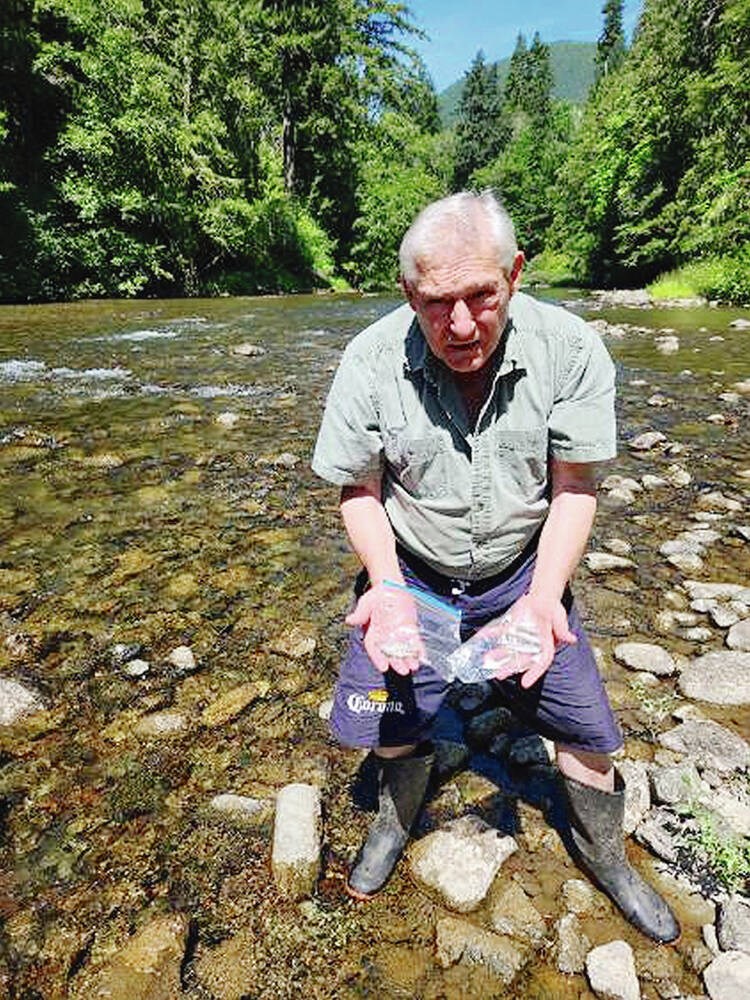Hundreds of tiny silver salmon and trout fry have been discovered dead at the bottom of a canyon at the base of Skutz Falls on the Cowichan River system and the cause of the mass die-off is a mystery.
Authorities are probing the dead fish and river conditions, trying to figure out what happened on one of the world’s pre-eminent fishing rivers, which has been attracting attention from anglers for more than a century.
“We don’t know what is going on. It’s terrible,” said Joe Saysell, who lives by the river and has been watching over it for decades. “In my 75 years years here I’ve never seen anything like this.” He’s hoping that federal and provincial governments will make it a priority to figure out the cause of the deaths.
It’s not known how many fish died and if they are continuing to do so, Saysell said Friday.
Predators eat dead fish quickly, so evidence can be difficult to find.
Graham Auger and daughter Heidi, 12, were snorkelling just below the falls on Saturday when the girl said there were dead fish.
“I dove down to take a look,” Auger said. “There were a couple of hundred-plus easily.”
Many were dead in the bottom of the canyon. It was clear fish were distressed — they were swimming sideways or were belly up, with their gills still moving, he said.
Saysell said the situation is “really really strange.”
He doesn’t know if the mortality is due to a toxin, water temperature or poor oxygen levels. An environmental consultant for Catalyst’s mill at Crofton used a 30-foot-long probe to check the temperature and oxygen and found them “not bad,” Saysell said.
The Cowichan River, a Canadian Heritage River and a B.C. Heritage River, is managed by a group including the province, Fisheries and Oceans Canada, Cowichan Tribes, the Cowichan Watershed Board, and Catalyst.
Samples of dead fish collected by Saysell and others are being tested. Governments, First Nations and company researchers are all investigating.
Saysell mainly saw dead coho salmon and rainbow trout fry about 7.6 centimetres (three inches) long on Sunday at the canyon.
At that size, they would be last year’s fry, Saysell said, since this year’s fry would be far smaller.
The fact that second-year fry are dying is “very very alarming,” he said.
This river originates on the easterly end of Lake Cowichan and is fed by a series of small creeks, B.C. Parks said.
First Nations people have historically relied on the salmon in the river.
Its diversity makes it what Saysell calls a “blue ribbon” river in the province. Chinook, coho and chum salmon, along with steelhead and rainbow, brown and cutthroat trout, are all found in the river.
Every summer, Cowichan River flows are reduced to ensure there is enough water saved for the river to flow year-round.
This year, the flow rate of four and a half cubic metres per second is the same as in the past couple of years, said Dave Mjoen, environmental specialist at the Crofton mill.
Flows are reduced by raising the weir in order to hold back enough water to sustain flows through the drier season. Flow rates are vetted by the stakeholders group.
In late June, the weir was raised over a number of days. The dead fish were found about a week and a half after the flow rate was altered, Mjoen said.
Company environmental professionals are checking the health of the river, he said.
Cowichan Tribes Chief Lydia Hwitsum, also co-chair of the Cowichan Watershed Board, said the nation’s fisheries staff spotted several dozen dead juvenile salmonids. The nation is working with other authorities to try to solve the puzzle of why this happened. “The loss of any number of fish is very concerning.”
Lower river flows and higher temperatures can increase stress on fish, making it more difficult for them to survive other pressures, the nation said.
Hwitsum said that on June 9, she wrote to B.C. Forests Minister Bruce Ralston and to Nathan Cullen, minister of Land Water and Resource Stewardship, citing concerns about “extremely low water levels in the Cowichan River jeopardizing the survival of wild salmon fry.”
Cowichan Tribes is repeating calls for the province to support a new and higher weir “so that that the river and salmon do not face these dire circumstances in the future,” she said.
“The acute need for replacement of the weir at Cowichan Lake has never been more evident as this year.”
Local leaders have been working for more than a decade to line up funds to pay for a new weir.
B.C. should match federal funds, Hwitsum said.
“The environmental, social and cultural importance of the Cowichan River is too important to delay any longer.”
>>> To comment on this article, write a letter to the editor: [email protected]



